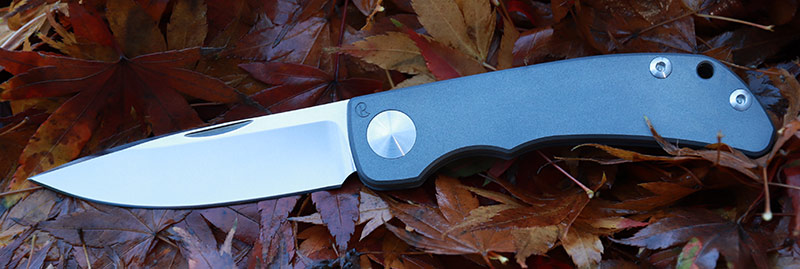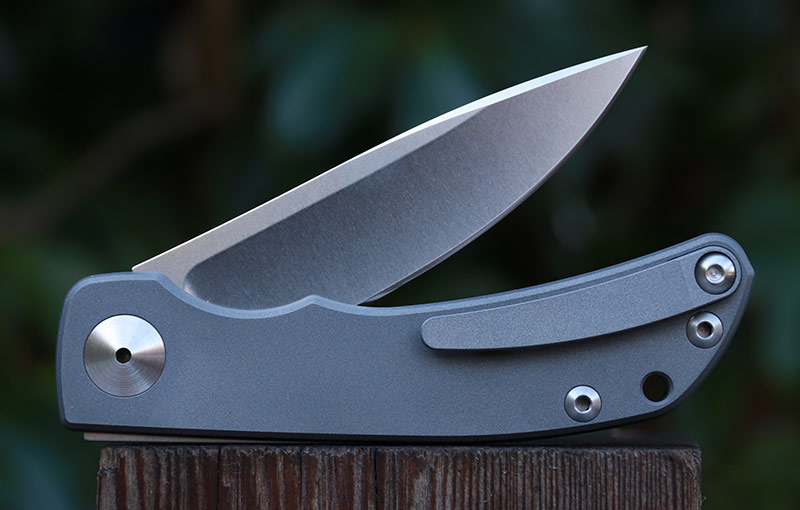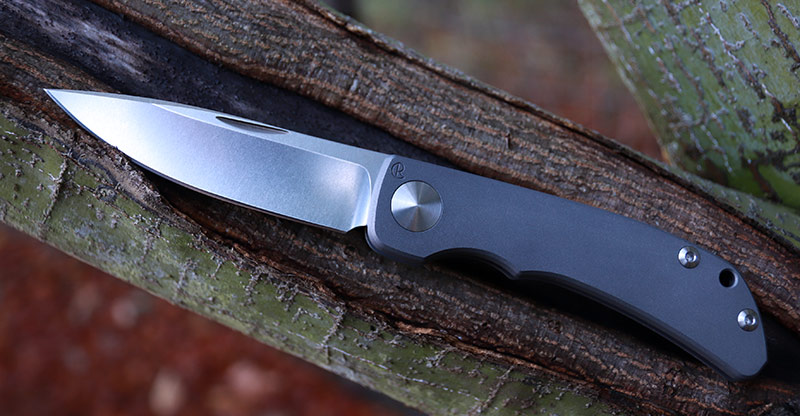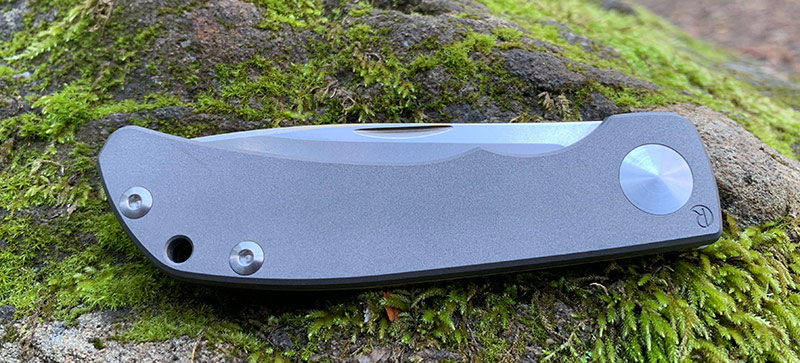We independently evaluate all recommended products and services. Any products or services put forward appear in no particular order. If you click on links we provide, we may receive compensation.
Since the 1980’s, Chris Reeve Knives has been making folding and fixed blade knives. Unless you’ve been living under a rock for over 40 years, you already know that. What you may not know, is that this knife company, with high tolerance folders at the forefront of their lineup, also makes one folder that doesn’t lock open. And it’s called the Impinda.

Designed in collaboration with another legendary name in knives, Bill Harsey, this small, modern slip joint is quite the diversion from the standard knives made at the Reeve factory. Of course, this isn’t Reeve’s first collab; they’ve also worked with Grant and Gavin Hawk to make the TI-Lock folder, the Yarborough (a special edition of the Green Beret fixed blade) again with Harsey, and many other special edition knives over the years. The Impinda does have a few unique features to it, but does it quantify a $450 slip joint in 2020? I’ll give you one guess how you can find out. Ok fine, just keep reading, we’ll try not to “slip” up and keep the “points” poignant.
Key Specs: Chris Reeve Impinda
Blade
As with just about any Chris Reeve knife here in 2020, the blade is comprised of S35VN blade steel. To keep from repeating the same mantra you’ll hear every time you read that blade steel composition, it’s a good steel. Not great by today’s standard, what with the slew of tool steels available (like Maxamet, Rex 45, CPM M4, and PSF27), higher end stainless steels (like Vanax Superclean, M390, and CTS-204p), but it’ll suffice for most day to day tasks, and hold up for many years of serviceable use. It’s stainless, somewhat tough, easy to sharpen, and moderate in edge retention.

Of course, the Reeve factory insists on putting their convex polished edge on all their knives, which seems to deviate a little from the steel’s potential a bit. What I’m saying is, the edge slips off material more than it tends to bite in and cut it, on a very regular basis. This is quite easily remedied by anyone with moderate sharpening skills, but is an aspect of their knives that I struggle with, especially with their price range. The (apparently soon) upcoming switch to S45VN by the Reeve factory is expected to change the feel in edge aggression for the better, as well as edge retention. Their heat treat has been spot on for a long while at 59-60 HRC, but I’m personally quite excited to handle and use their next-gen steel when it becomes their standard production steel composition.

With a 3.2” blade length, and 0.12” blade stock thickness, this modern take on a slip joint has been designed with EDC in mind. With a nail nick cut into the show side of the blade, simplicity in design had been maintained in the look of the Impinda blade. There is no steel designation (save for the capital “V” cut into the blade near the pivot under the handle scales on all S35VN blades), no brand name, no lettering, and no model name anywhere on the blade. Just a clean, stonewashed piece of steel, made to look as subdued as possible, in the most humble nature.
Deployment / Lockup
The deployment of a slip joint knife is almost always a two-handed affair, and you’ll find no diversion from this method with the Impinda. The provided nail nick does not seem to work in the typical fashion in my use, meaning it’s easier to just pinch the blade with the thumb and index finger and pull it open. So, there’s the basics of deploying the Impinda. It’s simple, opens to its “locked” open position, and stays there with positivity.

The pull on the blade, in terms of resistance, is quite heavy. Which is a little difficult to understand, since Bill Harsey and Tim Reeve (Chris’s son) designed the Impinda with a unique opening design. The shape of the back spring was made with an asymmetrical interface in relation to the blade. What this is supposed to do, is make the blade easier to open, than it is to close. This idea is truly genius; a non-locking blade that stays open with authority. But, in my use, the opening and closing of the blade seemed to feel the same in both directions in terms of resistance. I didn’t actually measure it with any kind of device, but paying close attention to the feel over and over, during the course of weeks, I wasn’t convinced that it made any notable difference.

The deployment was quite smooth, though, considering the blade is riding with constant contact with both the washers and back spring at all times. And when the blade gets to it’s fully opened position, it makes a clear, authoritative click, and stays there without and blade play from side to side. Using a stop pin in addition to the back spring, the blade gets 2 points of contact, rather than the single point of contact most slip joints get, typically only resting on the back spring. The tension holding the blade open inspires just the right amount of confidence to be able to use the blade in the correct direction (read, not prying with, or putting any pressure on the spine of the blade in the cutting task), without fear of it closing accidentally or unintentionally.
Closing the blade is fine, but I really wished to have seen a half stop on the back spring. Most traditional slip joints, which I understand the Impinda is not, have a position at which the blade will stop half way open, giving the user an “out” if the intention was not to close the blade quite yet, or to reposition the hand to get out of the blade path. Why would they design the back spring to have this unique “easy open, hard to close” philosophy, but then allow the blade to potentially slam closed prematurely? I believe they left the half stop out because the design of the back spring stops the blade from closing completely until it is very close to the end of its travel. But I still miss the half stop, for my admittedly particular tastes (but isn’t that what a review is hard-wired to do?).
Feature, Fit and Finish
Continuing with another premier feature, the Impinda (pronounced Im’ Peenda) touts an S35VN back spring. Whether or not it’s necessary for this particular knife is debatable, but I guess there’s got to be something special about a slip joint to make it worth $450. I do appreciate this feature, if not only because of the fact that the blade and the back spring will wear evenly with long term use. And here lies the reason people (myself included) continue to buy CRK products, even without the great Chris Reeve at the factory any longer. They engineer high end pieces of metal to fit together extremely well, and manufacture those parts to last a lifetime or more.

A small, yet consciously designed part of the Impinda, is the pivot. The pivot itself is round, like the other folders Chris Reeve Knives makes. But the pivot screw, specifically, has a “D” shape to the back of the head, which mates up to the “D” shape cutout on the handle scale. Again, a small detail, but a thoughtful one. Aiding in disassembly and reassembly, it’s little things like this that make the company a cut above.

The Sebenza 21 and 31, Inkosi and Umnumzaan all share the same style pocket clip, most of which are interchangeable. But the Impinda uses a different style than these other common CRK’s. This isn’t a bad thing, per se, but a notable change for those “competing the set” of Chris Reeve folders. What’s good about the clip, is that it uses the same clip screw and single tool disassembly, like the Sebenza.
Housed by the standard titanium handle scales used by all CRK folders, the Impinda carries the same sand blasted texturing used on other models. I personally like the texturing left by this process, as it has a little grip to it, and wears nicely. Yes, titanium is subjected to “snail trails” with just the slightest graze from an opposing material, but I think it looks better when used and loved than when it just sits in a box or on a shelf. After all, Chris Reeve started the company to make knives that are designed to be used, and kept for the long haul.

Fit and finish is great on the Impinda, with all parts fitting together with absolute precision and near perfection at all contact points. It’s a joy to take apart a CRK; they are designed so simply, come apart easily, and go back together with no sign of tampering. Everything just always fits back together just like when it was new, and only feels better with age and a fresh cleaning. Including all screws, the Impinda has only 12 parts. Comparing to something like a Paramiltary 2, which has 19 parts total, the Chris Reeve designs are kept to a minimum, on all their products.
Field Test
Keeping in mind that the Impinda is probably made to be something used as a “gentleman’s folder”, light EDC use is at the forefront of its design philosophy. So, I used it in that way. And, it works great for its intended use. The knife stays put in the pocket with a great pocket clip, opens smoothly (albeit two-handedly), cuts what you want to cut, and goes away until later.

With the Impinda, included in the box is one of Chris Reeve Knives’ leather slip and pocket clip insert, if you choose to carry the knife without a clip, but rather in the leather slip inside the pocket. But, this is the only folder they make (aside from the Mnandi) that doesn’t include a lanyard in the box. This seems a little odd, considering many users may prefer to use the included leather slip, but not having an easy way to retrieve the knife from the slip. Not a big deal, but odd nonetheless.
Alternatives
All these knives available at BladeHQ.
The Impinda, having a design collaboration with Mr. Harsey, lends the first idea of an alternative to the Spartan Harsey Folder (SHF). Another knife designed by Bill, and made by another company, the SHF is a frame lock folder, rather than the slip joint offered by the Reeve‘s factory. These two knives look strikingly similar, with the exception to the locking type a d available graphics and finishes.
The Harsey Folder has the advantage in the steel department, using S45VN (which is coming soon to a Reeve knife near you), and costs $460 – $640 depending on the handle scale graphics, size and blade steel (some models still use the S35VN found on the Impinda). Looking at these two knives side, it’s obvious even to the untrained eye, that these knives are brothers… or cousins… but whatever the case, they share an extremely similar design language, with the SHF being likely a better value for the money.
Trying to find another comparable slip joint production knife in this price range is quite limited, but the Hinderer Slippy is close. It’s another slip joint, has nearly the same blade length (3.0” vs the Impinda’s 3.125), 1/4 of an ounce in weight difference (3.38 on the Impinda vs 3.65 on the Hinderer), but still comes in at $135 less than the Impinda ($315 vs $450).

The Slippy has a thumb disk for opening, making a one handed opening task feasible. And, it uses a much higher end steel, CPM-20CV. The Slippy comes in about 20 different flavors, with different blade coatings (black stonewashed, satin stonewashed, or working finish), and comes in many different scale options (like g10 in many different colors, and wood). The blade shape is also available in different varieties, with the sheepsfoot and drop point rounding out the insane level of options that Hinderer puts out for this knife.
Conclusion
$450 for a slip joint, that comes in only one variety, and costs just the same as the company’s locking knives, justifies a deal breaker in my book. The Impinda has two brand new features never seen in a slip joint before; the S35VN back spring, and the offset resistance in opening and closing. But do these two features alone make the Impinda worth the money? Or does the evergreen Chris Reeve Knives name give enough value to the brand that this knife is worth this asking price? I think not.

S35VN is on its way out of the Reeve factory, the knife is not nearly as smooth as their locking knives, and the special features just don’t add up to the asking price. It’s not a bad knife by any means, but just doesn’t do a good job of justifying its price point for what it offers. “Next!”
- Unique features, classic CRK materials and design, nice pocketable size.
- Too expensive for the sum of its parts, better alternatives available, standard CRK smoothness is lost.
Chris Reeve Impinda
Quality/Performance - 82%
Value for Money - 67%
75%
The Impinda is not a bad knife by any means, but just doesn’t do a good job of justifying its price point for what it offers.





